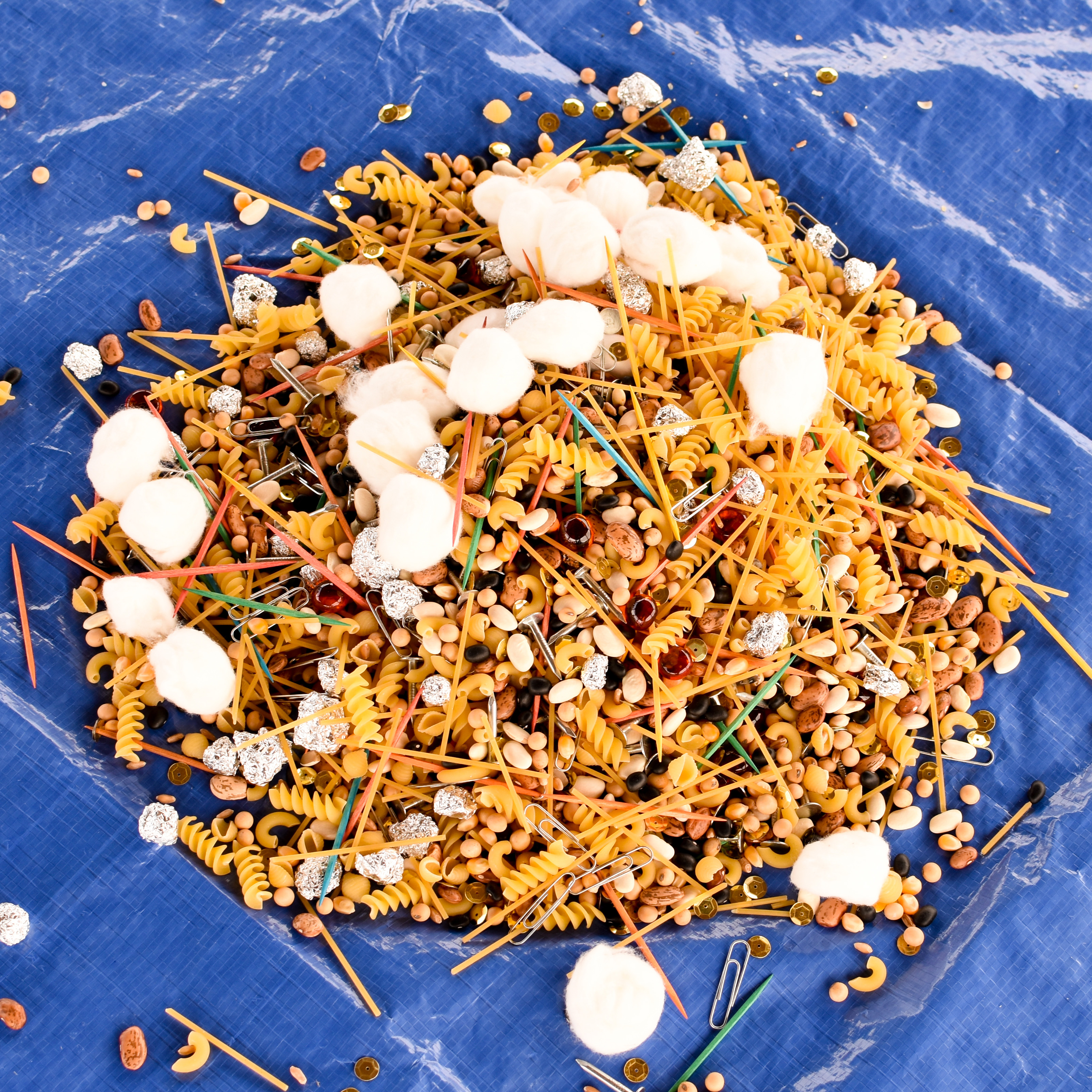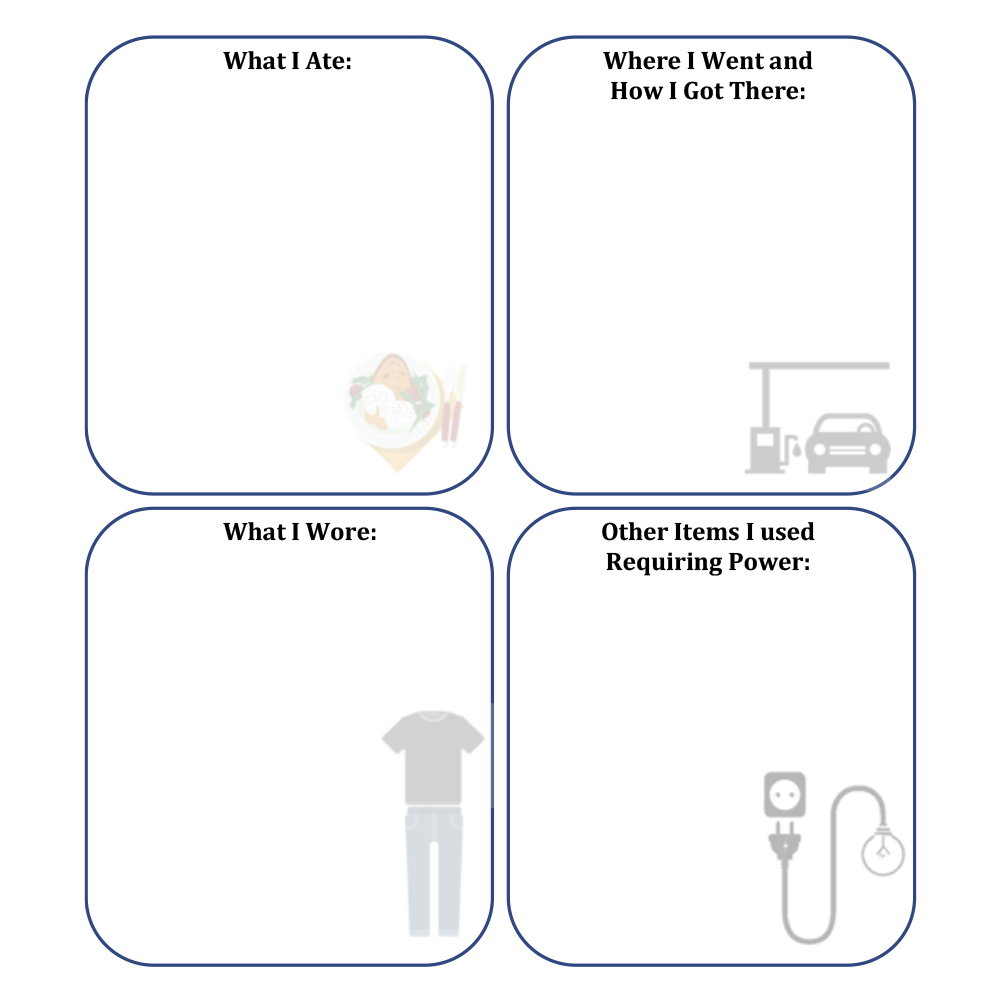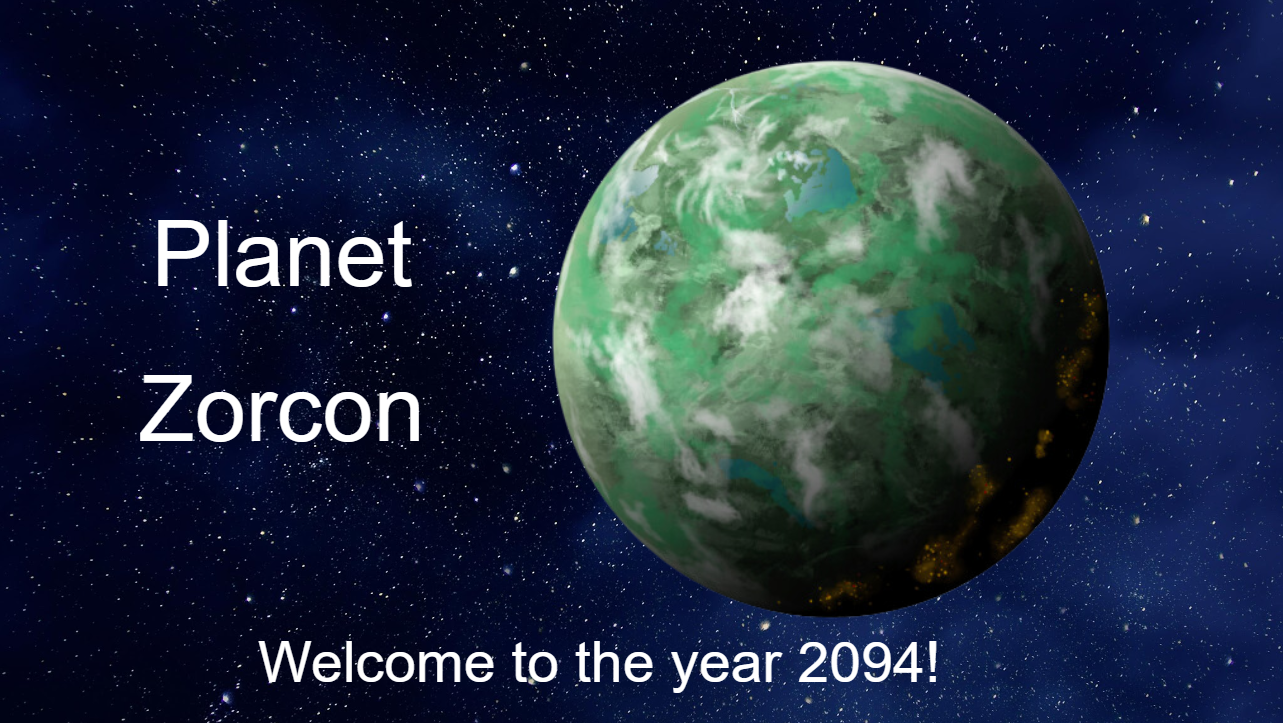 Relevancy and Engagement
oklahoma.agclassroom.org
Relevancy and Engagement
oklahoma.agclassroom.org
Planet Zorcon (Grades 6-8)
Grade Level
Purpose
Students explore the connection between individual behavior and resource use, learn the difference between renewable and nonrenewable resources, and identify careers related to natural resource management by playing an active, futuristic simulation game in which teams have to collect limited resources from "Planet Zorcon." Grades 6-8
Estimated Time
Materials Needed
Engage:
- All in a Day... handout, 1 copy per student
- Pretest: What Are Resources? 1 per pair of students (optional)
- Pretest Answer Key (optional)
Activity 1: Seeing is Believing
- All in a Day... handout (continued from Engagement Activity)
- Growing Appetites, Limited Resources video
- Renewable vs Non-renewable vs Inexhaustible Resources e-magazine, digital student access
- Optional print-version is available
- Green, red, and blue colored pencils
Activity 2: Mission to Planet Zorcon
 Planet Zorcon slides
Planet Zorcon slides
- If you do this activity outside or in an area without a projector, print the slides (multiple to a page) to take with you.
- Save your own copy of this slide deck.
- Plastic storage bin with lid*
- Gallon-sized Ziploc bags,* 1 per group plus extras to hold resources
- 1–1½ cups of each of the following "resources":* wheat seeds, cotton balls, corn, toothpicks, soybeans, pinto or brown beans, shell macaroni, spiral macaroni, elbow macaroni, paper clips, black beans, amber pebbles, sequins, 1" roofing nails, silver balls (foil or other material), white beans, and 2" pieces of spaghetti
- Duct tape*
- 8' x 10' tarp*
- Plastic spoons, 5 per group*
- Plastic cups, 2 per group*
- Zorcon Research Staff ID Badges,* 1 set per group
- Resource Inventory activity sheet, 1 copy per group
- Calculators (optional)
*These materials are included in the Planet Zorcon Kit, which is available for purchase from agclassroomstore.com.
Activity 3: Careers in Natural Resources
Vocabulary
inexhaustible resource: natural resource that can last forever regardless of human activities
nonrenewable resource: limited natural resource that cannot be replaced or reproduced within a generation and cannot be managed for renewal; examples include oil, soil, mineral resources (lead, iron, cobalt, zinc, etc.)
renewable resource: natural resource that can be replaced naturally or by human efforts at a sustainable rate; examples include forests, fish, wildlife, plants, animals
Did You Know?
- About 91% of the energy consumed in the United States comes from nonrenewable energy sources, which include uranium ore and the fossil fuels — coal, natural gas, and petroleum.1
- Renewable energy sources including biomass, hydropower, geothermal, wind, and solar provide 9% of the energy used in the United States. Most renewable energy goes to producing electricity.1
- The energy sources we use to make electricity can be renewable or nonrenewable, but electricity itself is neither renewable nor nonrenewable.1
Background Agricultural Connections
The things we use every day come from the earth. Nearly all of our daily activities use some kind of resource that is grown on a farm, harvested from the wild, mined, or extracted from deep below the soil. You may awaken in the morning on sheets made of cotton, under a blanket made of wool or synthetic polyester. Cotton is grown on a farm, wool comes from sheep raised on a farm, and synthetic polyester, like most plastics, is made from petroleum, which is extracted from the earth. The soap you use in the shower might contain cottonseed oil, while the tile, metal, and glass are made from mined materials. Wallpaper can be adhered to the wall using wheat paste, and paint contains compounds from trees. The linoleum on the floor is made from soybean oil, the wood flooring came from trees, and the nails holding it together are made from materials that were mined from the earth. The electricity powering the lights may come from water running through a hydroelectric dam or from coal burned at a power plant. It’s difficult to imagine what our lives would be like without the natural resources that provide us with electricity, materials for the everyday items we use, and food to nourish our bodies.
It can be an eye-opening experience to consider the resources that one uses in a single day, especially considering that some resources are nonrenewable. Nonrenewable resources cannot be replaced within a generation, so once they are gone, we have to make do without them. Fossil fuels and soil are two important nonrenewable resources. Both are formed very slowly by natural processes and both play central roles in our lives. While the act of using fossil fuels depletes the supply, this is not necessarily the case with soils, which can be managed for long-term use. Erosion destroys topsoil, but good management can prevent erosion.
Soil that is managed well can support many years of cropping. Crops are a renewable resource because they can be managed for replenish themselves regularly. For example, a tree farm can be managed so that some trees are ready for harvest each year. After trees are cut down to be turned into paper or lumber, more trees are planted that will renew the supply several years in the future. Crops like wheat and corn are planted and harvested within a single growing season, so they can be used up and then renewed each year.
Some resources are considered inexhaustible, meaning that human activities will not affect the supply; they can last forever. Sunlight, water, and air are examples of inexhaustible resources. People cannot destroy these resources or create more of them, but we can affect their quality. Pollution can render air unbreathable and water undrinkable. Because we depend on natural resources to survive, it is important that we use them carefully. There are many careers in the field of natural resource management that seek to maintain the quality and productivity of earth’s resources.
Whether a resource is nonrenewable, renewable, or inexhaustible it needs to be managed to the best of our knowledge to maintain the sustainability of the resources we need to survive. The tragedy of the commons is a term used in social science to describe a situation in a shared-resource system where individual users act independently according to their own self-interest and behave contrary to the common good of all users. The result depletes or spoils the resource.
Engage
Complete this section of the lesson one class period BEFORE you want to start the lesson.
- Ask students the following questions:
- “Is the population of the earth increasing or decreasing?” (increasing)
- “With an increasing population, what kind of things do we need more of?” (food, water, shelter, electricity, etc.)
- “Where do these resources come from?” (They are farmed or mined from the earth using the natural resources that are here such as water, soil, etc.)
- “Is there a chance that any of these natural resources could run out?”
- Give each student one copy of the All in a Day... handout. Instruct them to keep a 24-hour log of everything they eat, what they wear, the devices they use that require power, and where they go and how they get there. Tell students that they will be assessing the type of resources their activities require on a day-to-day basis.
- Optional: See the attached pretest and key if you'd like to assess your student's prior knowledge.

Explore and Explain
Activity 1: Seeing is Believing
- Play the video Growing Appetites, Limited Resources. Ask students to pay attention to the importance of energy in our lives and what energy sources we currently use.
- Have students pull out their All in a Day... handout. Have students begin discussing some of the items they have listed in the four categories. Have students add to their log as needed.
- Explain to students that everything on their list came from two places — agriculture or mining. Define each of these words.

- Ask students to identify which items entered in their logs required agriculture and which required mining. Here are some items to look for in the log and to use as prompts:
- Bedding: cotton sheets, wooden bed frames (agriculture)
- Metal tables and desks (mined resources)
- Computers, cell phones and other electronics (mined resources)
- Wall coverings & floorings: paint, wallpaper, wood, linoleum, wool rugs, floor wax (agriculture)
- Personal needs: soaps, shampoo, cosmetics, deodorants, perfumes (Many products come from agriculture and the plastic containers that hold them come from mining.)
- Sporting goods: leather or rubber balls, mitts, bats (Both agriculture [leather] and mining [plastics])
- Transportation: cars, buses, and petroleum fuel (Mostly mined. Ethanol in fuel would be from agriculture, but only accounts for a small percentage of fuel.)
- Food: Fruits, vegetables, grains, and protein (agriculture)
- Provide digital access to the e-magazine Renewable vs Nonrenewable vs Inexhaustible Resources and give each student a green, blue, and red colored pencil or highlighter. Inform students that they will be learning about three different types of resources that our Earth provides.
- Instruct the students to:
- Read the e-magazine and click on the interactive links (video clip on page one and google slide presentation on page four).
- As they read, they should highlight the type of resources used for each item listed on their All in a Day... handout:
- Renewable = green
- Nonrenewable = red
- Inexhaustible = blue
- On page four they should click on the "Let's find out!" button and view the slide show. Students should list each resource in the correct classification on the back of their All in a Day... handout.
- After students complete the e-magazine, answer questions as needed and perform a formative assessment to see if they understand the difference between renewable, nonrenewable, and inexhaustible resources.
- Renewable Resources: Natural resources that can be replaced by human efforts are considered renewable. The supply of these resources can be reduced without proper management. Examples: forests, fish, wildlife, agriculture, plants, animals.
- Nonrenewable Resources: These are limited natural resources that cannot be replaced or reproduced (within a generation). We cannot manage them for renewal. Once they are gone they are gone—forever.Examples: oil, mineral resources (lead, iron, cobalt, zinc, etc.), soil (made so slowly: 1,000 - 500,000 years).
- Inexhaustible Resources: These are natural resources that can last forever regardless of human activities. They renew themselves continuously. This does not mean that resources are not limited. Human misuse can damage these resources. Examples include available surface water (little can be done to affect the total amount of water, but it can be contaminated), air (we can damage the air with pollution, but we cannot use it up), and sunlight (pollution can limit this resource).
Activity 2: Mission to Planet Zorcon
NOTE: This is a very busy activity! Be sure to have plenty of space, and conduct this activity where students will not disrupt other classes. A great outdoor activity. Review the directions carefully and note the preparation time that is required.

Preparation:
- Tape the tarp on the floor in a central area. If you are doing this in your classroom, move all the desks against the walls. Draw a large circle (at least four feet in diameter) in the center of the tarp to represent Planet Zorcon.
- Copy enough Zorcon Research Staff ID Badge sets for your class, printing each set on a different color of paper (for the purpose of clean-up; same colors go together). There are five badges per group, so if you have 30 students you will need six sets. You will also need some students to serve as Government Inspectors—if the number of students in the class is not evenly divisible by five, you can assign the remaining number to this role.
- For each group, place one set of Zorcon Research Staff ID Badges, 5 spoons, and 2 cups in a gallon-sized Ziploc.
- Fill another Ziploc with the “resources” (see the Materials List).
- Print or set up a computer/projector to project the Planet Zorcon slides to guide your students through the simulation.
 Activity 3: Careers in Natural Resources
Activity 3: Careers in Natural Resources
- Explain that there are many careers available in natural resource management ranging from research and education to policy development and law enforcement.
- Have students recall the career positions from the Planet Zorcon simulation (Project Director, Security Officer, Data Collector, Surveyor, Resource Specialist, and Government Inspector.) Explain that these are all careers in natural resource management.
- View the Careers in Natural Resources YouTube playlist. Share a selection of career video clips with the class. This may be done as a class, in small groups, or individually. You can also refer to the Natural Resource Career Spotlights on the Ag Explorer website.
Career Spotlight: Conservation Officer
The "Project Director" in the Planet Zorcon simulation could be related to a career as a Conservation Officer. They work with conservationists to secure and protect natural resources. Explore the career profile for a Conservation Officer to discover job outlook, education requirements, and average salaries.
Elaborate
-
Dig deeper into the concept of the Tragedy of the Commons by listening to the NPR podcast, The Bottom of the Well. Discuss the possibility of water wells drying up in residential areas or on farms that provide our food. Discuss agricultural water requirements to produce our food supply. Look at the chart showing The Amount of Water Needed to Grow These Crops. Relate what students learn from the podcast to Planet Zorcon.
-
Use the activities from the lesson Corn an A-maizing Plant: Food, Fuel, and Plastic to further explore the connections between agriculture and natural resource use.
Evaluate
- Have students watch the video from the beginning of the lesson, A Guide to the Energy of the Earth, a second time. Discuss how their impressions and understanding of the video changed after having learned about renewable and nonrenewable resources.
- After conducting these activities, review and summarize the following key concepts:
- Use and consumption of natural resources impact Earth's systems.
- Resource use has benefits and consequences for both people and the environment.
- There are a variety of rewarding careers available in natural resource management.
Sources
The original lesson plan was adapted from What will tomorrow bring? from the International Office of Water Education, Utah State University. The lesson was updated in 2020 by the National Center for Agricultural Literacy.